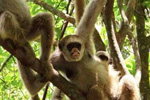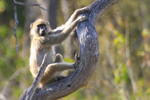
Adult Peruvian night monkey. Photo by: Jean Paul Perret/NPC.
The Peruvian night monkey (Aotus miconax) is one of the world’s least known primates, having never been studied in the wild–until now. Found only in the cloud forests of northern Peru, a group of scientists with Neotropical Primate Conservation and the National University of Mayor San Marcos have spent 12 months following a single group of this enigmatic monkey species in a small forest patch. The results of their research, published in mongabay.com’s open access journal Tropical Conservation Science, shows that protecting forests, even small forest fragments, is vital to the species’ survival.
Currently, the IUCN Red Lists categorizes the Peruvian night monkey as Vulnerable, however the scientists write in their paper that the IUCN is “underestimating habitat loss and fragmentation” and the species more closely fits Endangered.
“It is only known from collection localities in the departments of Amazonas, Huánuco and San Martin. These same departments have some of the highest deforestation rates in Peru,” the researchers explains. “Deforestation in the area is fueled by immigration of people from the central and northern highlands looking for land for agriculture, cattle ranching and timber extraction.”
 The Peruvian night monkey study group in vine tangle nest. Photo by: Sam Shanee/NPC. |
On the bright side, the researchers found that the species is capable of surviving in highly-fragmented forest. They followed a family group of six making-do in a single forest fragment only 1.4 hectares (3.4 acres) large.
“The study group has one of the smallest home ranges recorded for a night monkey group, probably the result of its isolated habitat,” the researchers write.
They recorded that the Peruvian night monkey group spent more time traveling and foraging than other species of night monkey, and theorize that this may be in response to their degraded habitat or in keeping warm in a colder environment. They also documented the group leaving the forest patch from time-to-time, probably necessary for survival.
“The continued presence and reproduction of [the Peruvian night monkey] in this heavily disturbed area suggests that the species is able to survive in isolated habitat close to human settlement; therefore the conservation of forest fragments is of importance,” the researchers conclude. “Special emphasis should be made in preserving connectivity to allow genetic flow between groups.” Forest corridors are needed to link up disparate groups, insuring that Peruvian night monkeys don’t begin suffering from in-breeding.
There are currently eleven night monkey species known in South America, all of them in the Aotus genus. They are the world’s only truly nocturnal monkeys.
CITATION: Shanee, S., Allgas, N., and Shanee, N. 2013. Preliminary observations on the behavior and ecology of the Peruvian night monkey (Aotus miconax: Primates) in a remnant cloud forest patch, north eastern Peru. Tropical Conservation Science Vol. 6(1):138-148.
Related articles
Endangered muriqui monkeys in Brazil full of surprises

(11/26/2012) On paper, the northern muriquis (Brachyteles hypoxanthus) look like a conservation comeback story. Three decades ago, only 60 of the gentle, tree-dwelling primates lived in a fragment of the Atlantic Forest along the eastern coast of Brazil. Now there are more than 300. But numbers don’t tell the whole story, according to anthropologist Karen Strier and theoretical ecologist Anthony Ives of the University of Wisconsin, Madison. The pair analyzed 28 years of data on the demographics of the muriquis, one of the longest studies of its kind. They found surprising patterns about birth and death rates, sex ratios, and even how often the monkeys venture out of their trees. These findings raise questions about the muriquis’ long-term survival and how best to protect them, the scientists wrote in the Sept 17 issue of PLoS ONE.
The world’s 25 most endangered primates: nearly a quarter in Madagascar
![]()
(10/15/2012) A coalition of conservation groups released the biannual Top 25 Primates list today, including nine species not appearing on the 2010 list, at the UN’s Convention on Biological Diversity (CBD) in Hyderabad, India. Madagascar tops the list as home to the most threatened primates, including six on the list. Following Madagascar, Vietnam contains five, Indonesia three, and Brazil two. In all, over half (54 percent) of the world’s primates, which have been evaluated, are considered threatened by the IUCN Red List.
Mr. Darcy and the Manic Pixie Dream Girl: monkeys display distinct personality types

(10/01/2012) Remember the ‘man with no name’ played by Clint Eastwood in A Fistful of Dollars, Mr. Darcy in Jane Austen’s Pride and Prejudice, or the bubbly cute girl in every romantic comedy from Legally Blonde to Breakfast at Tiffany’s? Each of these characters represent an over-the-top type of human personality—loner (man with no name), aloof (Darcy), and nice (the bubbly cute girl)—but a new study in the Proceedings of the National Academy of Sciences (PNAS) finds that it’s not only humans that show such distinct types, but baboons as well. Studying 45 female chacma baboons in Botswana’s Moremi Game Reserve over seven years, the researchers found that such personality types, unrelated to social statues, helped to determine the animals’ overall sociability and the stability of their relationships.